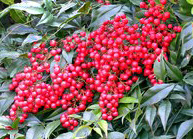
A new invasive exotic, heavenly bamboo, pictured, (Nandina domestica) has been observed naturalizing in the Springfield, Missouri area. It already is widespread in Arkansas and other southern states and likely will be a problem throughout much of Missouri, according to a warning from Susan Farrington, a spokesperson for the Missouri Native Plant Society.
"Nandina is very hard to remove manually," Farrington said. "Roots are very difficult to pull up and even a tiny piece of root left will resprout." She suggests that shrubs should be sprayed with Glyphosate when other plants are dormant. Mostly she warns not to plant it in the first place.
Nandina berries contain cyanide and have been documented to kill birds is Farrington's biggest concern. She explains that since it is from Asia, American birds did not evolve with it and dont recognize it as toxic. Acute toxicity is related to the amount of berries consumed: cedar waxwings were killed by it because of their voracious eating habit. When birds eat only a few berries, they survive and spread the species. It is also dangerous for pets and livestock (or children!) if they eat too much of it.
It grows in sun or shade and will become thick in the forest understory, like bush honeysuckle. It grows 6-8 feet tall, or 3-4 feet for dwarf varieties. It is commonly used in the landscape trade because of its pretty red berries and generally evergreen form.
Information from the Clemson Cooperative Extension seems to extol the large plants benefits, calling it tough and durable and deer resistant. "Large plants have been growing in South Carolina for 100 or more years without any care," seems to be more of a brag than a warning from this source.
Checking on the popularity of the plant like most controversies reveals heated debate about even whether it is an invasive species. However, according to Jerry W. Davis, a certified wildlife biologist from Hot Springs, Arkansas, "the US Department of Agriculture and most states classify Nandina domestica as a noxious, non-native, invasive weed....."
Go Back | 






